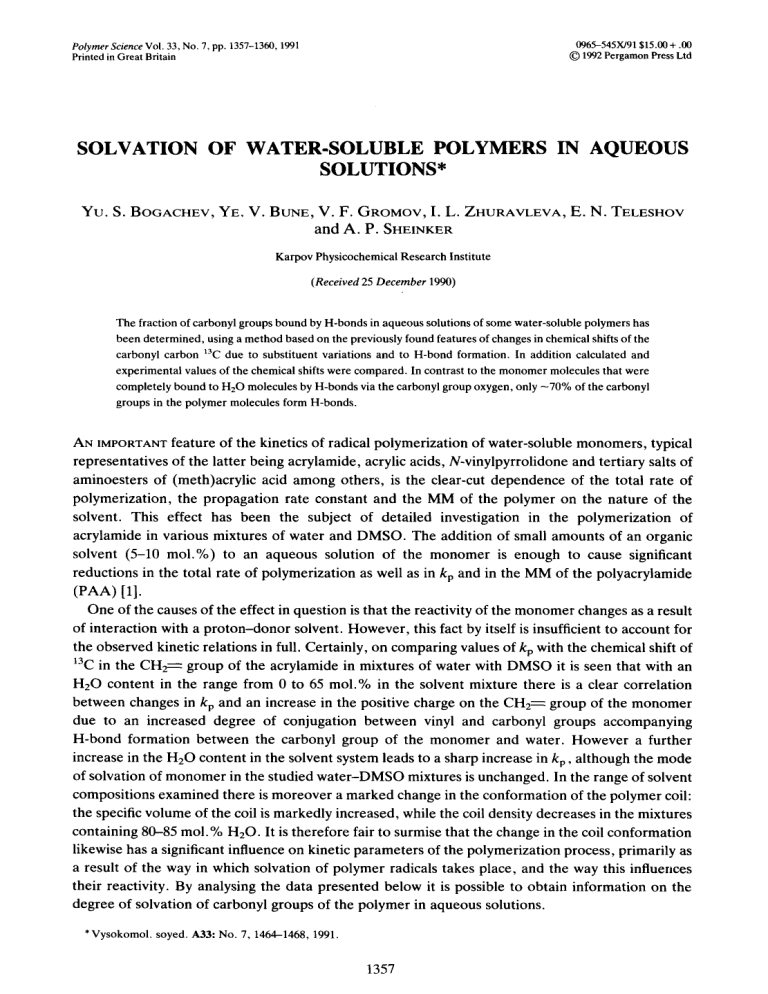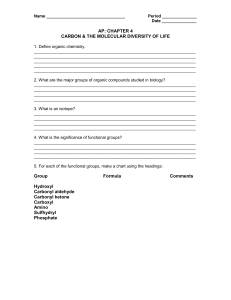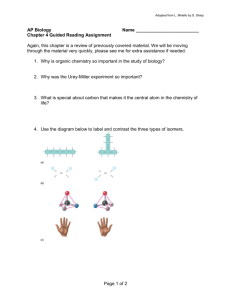Solvation of Water-Soluble Polymers in Aqueous Solutions
advertisement

Polymer Science Vol. 33, No. 7, pp. 1357-1360, 1991 0965-545X/91 $15.00 + .00 © 1992 Pergamon Press Ltd Printed in Great Britain SOLVATION OF WATER-SOLUBLE POLYMERS IN AQUEOUS SOLUTIONS* Y u . S. BOGACHEV, YE. V. BUNE, V. F. GROMOV, I. L. ZHURAVLEVA, E. N. TELESHOV and A. P. SHEINKER KarpovPhysicochemical Research Institute (Received 25 December 1990) The fraction of carbonyl groups bound by H-bonds in aqueous solutions of some water-soluble polymers has been determined, using a method based on the previously found features of changes in chemical shifts of the carbonyl carbon 13C due to substituent variations and to H-bond formation. In addition calculated and experimental values of the chemical shifts were compared. In contrast to the monomer molecules that were completely bound to H20 molecules by H-bonds via the carbonyl group oxygen, only - 7 0 % of the carbonyl groups in the polymer molecules form H-bonds. AN IMPORTANTfeature of the kinetics of radical polymerization of water-soluble monomers, typical representatives of the latter being acrylamide, acrylic acids, N-vinylpyrrolidone and tertiary salts of aminoesters of (meth)acrylic acid among others, is the clear-cut dependence of the total rate of polymerization, the propagation rate constant and the MM of the polymer on the nature of the solvent. This effect has been the subject of detailed investigation in the polymerization of acrylamide in various mixtures of water and DMSO. The addition of small amounts of an organic solvent (5-10 mol.%) to an aqueous solution of the monomer is enough to cause significant reductions in the total rate of polymerization as well as in kp and in the MM of the polyacrylamide (PAA) [1]. One of the causes of the effect in question is that the reactivity of the monomer changes as a result of interaction with a proton-donor solvent. However, this fact by itself is insufficient to account for the observed kinetic relations in full. Certainly, on comparing values of kp with the chemical shift of 13C in the CH2-- group of the acrylamide in mixtures of water with DMSO it is seen that with an H20 content in the range from 0 to 65 mol.% in the solvent mixture there is a clear correlation between changes in kp and an increase in the positive charge on the C H 2 ~ group of the monomer due to an increased degree of conjugation between vinyl and carbonyl groups accompanying H-bond formation between the carbonyl group of the monomer and water. However a further increase in the H20 content in the solvent system leads to a sharp increase in kp, although the mode of solvation of monomer in the studied water-DMSO mixtures is unchanged. In the range of solvent compositions examined there is moreover a marked change in the conformation of the polymer coil: the specific volume of the coil is markedly increased, while the coil density decreases in the mixtures containing 80-85 mol.% H20. It is therefore fair to surmise that the change in the coil conformation likewise has a significant influence on kinetic parameters of the polymerization process, primarily as a result of the way in which solvation of polymer radicals takes place, and the way this influences their reactivity. By analysing the data presented below it is possible to obtain information on the degree of solvation of carbonyl groups of the polymer in aqueous solutions. * Vysokomol. soyed. A33: No. 7, 1464-1468, 1991. 1357 1358 Yu. S. BOGACHEVet al. The conformational state of the polymer is determined by the character of its interaction with solvent. A major factor in this interaction is the ability of the O atom of the carbonyl group of the water-soluble polymer to form H-bonds when one goes from organic solvents that are H-acceptors to aqueous solutions. In an earlier study [2] we determined the laws of change in chemical shifts of the carbonyl carbon lac accompanying variations of substituents and resulting from H-bond formation. With the data given in [2] we can calculate shifts of the carbonyl carbon 13C for any compound of the type RCOX, provided that the H-bonds are formed by carbonyl oxygen atoms. Comparing the calculated values of the shifts 8c with the experimental ones we obtain the number of carbonyl groups in a compound that takes part in the formation of H-bonds, and in this way information about the state of the COO and CO groups in the studied compounds is obtained. This method was used successfully to characterize the state of the groups in question in a number of water-soluble monomers in solutions in organic solvents and water [2]. In the present instance the method was used to obtain similar information for water-soluble polymers. To determine the shift of the cabonyl carbon 13C we used the formula 8(RCO) = 8(RoCO) + A(R) + Al-m, where A(R) and AHB are increments for the influence of the substituent R and for the formation of H-bonds by the carbonyl oxygen atom respectively; 8(RoCO) is the shift of the carbonyl carbon 13C of the reference compound that is in a solvent which is an H acceptor. By analysing a large amount of data published in the literature as well as the results obtained by ourselves we were able to determine the values of AHB and A(R). The Ann values for various carboxylic acids, as well as for their esters and amides, are 4.0, 4.0 and 5.0 ppm respectively. The value of A(R) vails according to the nature of the substituent R [2]. To determine the values of 8c in the polymers we took as a reference compound PMMA in dioxane, which is an H acceptor, and does not take part in the formation of intermolecular H-bonds with the carbonyl groups of the polymer. Let us now determine the value of 8c for polyacrylic acid in water and in an organic solvent that is solely an H-acceptor and is unable to form H-bonds with carbonyl O atoms. On going from fragment --H2C--HC---CH 2 to the fragment --H2C--(CH3)C---CH 2 the increment for the substituent influence is increased by 2 ppm [2]. Taking account of this fact, and putting the value of 8c for PMMA in dioxane at 178 ppm, we obtain 8c = 176 ppm for polymethyl acrylate. Putting the increment for H-bonding at 8c = 4 ppm for the esters, the value of 8c for polymethyl acrylate in an aqueous solution is 180 ppm. The difference in the 8c values for the carbonyl carbon in methacrylic acid and for its methyl ester in an aqueous solution is I ppm [2, 3]. Assuming the difference to be the same for the polymers the value of 8c for polyacrylic acid in an aqueous solution and in a solvent that is an H-acceptor will be 181 and 177 ppm. The chemical shift for the polymer in solution in an H-acceptor obtained in this way agrees with the experimental value of 8c in DMSO (see Table 1). This agreement validates principles on which the evaluation of 8c is based. The theoretically anticipated value of 8¢ in an aqueous solution is I ppm more than the tabulated experimental value. This is because not all the carbonyl oxygens of the polymer form H-bonds with H 2 0 molecules. The real difference in the values of 8c for polyacrylic acid in water (180 ppm) and in DMSO (177 ppm) is 3 ppm, so we deduce that only 75% of the carbonyl groups in the polymer are linked by H-bonds in aqueous solutions. We have now to consider a situation involving the solvation of PAA and polyvinylpyrrolidone (PVP) in an aqueous solution. On going from organic solvents (H-acceptors) to the aqueous solution the values of 8c for PAA and PVP change by 2.6 and 3.6ppm respectively. This is Solvation of water-soluble polymers 1359 TABLE 1. THEORETICAL 8Ct AND EXPERIMENTALLY MEASURED ~Ce VALUES OF THE SHIFI'S OF THE CARBONYL CARBON 13C FOR WATER-SOLUBLE POLYMERS IN APROTONIC SOLVENTS (H-ACCEPTORS) IN AQUEOUS SOLUTIONS ~ct Polymers Polyacrylic acid Polyacrylamide Polyvinylpyrrolidone Sulphate of polydimethylaminoethyl methacrylate ~ce 8ct H-acceptor 177.0 176.7 157.2 177.5 177.0 178.0 175.2 -- ~c° Water 181.0 181.7 180.2 181.5 180.0 180.6 178.8 180.1 Note. The reference compound was PMMA in dioxane for which 8c = 178.0 ppm. significantly less than the corresponding changes in 8c for the monomers and is less than the increment for H-bonding via the amide carbonyl group, which is 5 ppm. As was shown above, increment theory gives a value of 6c = 181 ppm for polyacrylic acid in an aqueous solution. The value of 8c for the acrylamide carbonyl carbon in aqueous solutions is 0.7 ppm more than that for acrylic acid, so we surmise that in an aqueous solution of P A A , provided that all the carbonyl groups are forming H-bonds with H 2 0 molecules, the shift of the carbonyl carbon 13C is equal to 181.7 ppm. This value is 1.1 ppm more than the experimentally measured value, which is 180.6 ppm. Allowing for the increment for H-bonding AHB = 5 ppm the value of ~c for P A A in an organic solvent (an H-acceptor) will be 176.7 ppm.* It is evident from these findings that in aqueous solutions the fraction of carbonyl oxygen atoms of P A A that form H-bonds with H 2 0 molecules is equal to 0.78, and is practically the same as for polyacrylic acid. The value of ~c = 181.7 ppm in aqueous solutions can be used to find the theoretical value of ~c for PVP in aqueous solutions. To do so we must add to 181.7 ppm the difference in the theoretical values of the chemical shifts of the carbonyl carbon for P A A (176.7 ppm) and PVP (175.2 ppm) in an H-acceptor (see Table 1). Comparing the value of 6c obtained in this way with the experimental value of 8c for PVP, we obtained the fraction of carbonyl group O atoms participating in H-bonding with H 2 0 molecules. Calculations show that 72% of the carbonyl groups of the polymer take part in the formation of H bonds. The laws referred to above hold equally for aminoesters of methacrylic acid and their polymers. Allowing for increments in the influence of substituents for the chemical shift of ~3C of the carbonyl carbon we can evaluate this parameter for polydimethylaminoethyl methacrylate ( P D M A E M A ) in aqueous solutions. On replacing the methyl group in the M M A ester group with the diethylaminoethyl group there is a change of 0.5 ppm in the chemical shift of the carbonyl carbon [3]. We therefore put the value of ~c for polymethyl methacrylate in dioxane at 178.0 ppm, and the value for the ester was put at 4.00 ppm. We next calculated the value of 6c for polyethylaminooctyl methacrylate ( P D E A E M A ) in dioxane in aqueous solutions. According to these calculations the values of ~c for P D E A E M A in these solvents are 177.5 and 181.5 ppm. At the same time the experimentally measured value of the chemical shift of the carbonyl carbon for the sulphate of P D M A E M A in aqeuous solutions is 180.1 ppm. *It can be seen from the tabulated data that the experimental value of ~c for PAA is more than the theoretical value. This is the result of a self-associationprocess taking in PAA, as in this case H-bonds are formed between carbonyl and amide groups in acrylamide units, which in turn accompanied by an increase in 8c. Comparing the experimental and theoretical values of 8c for the polymer and monomer, it appears that the self-associationprocess is more marked in the polymer than in the monomer. It is noteworthy that polyacrylic acid in solution in DMSO shows an almost complete absence of any self-association (see Table 1). 1360 Yu. S. BOGACHEVel al. In earlier work it was found that aminoester protonation via the N atom does not affect the chemical shift of the carbonyl carbon. Moreover it is only the nearest two C atoms that have a major influence on this chemical shift. We therefore surmise that the chemical shift of the carbonyl carbon for the salt form of P D M A E M A in an aprotonic solvent will be the same as for the unprotonated PDEAEMA, i.e. 8c-- 177.5 ppm. In this case when we go from solution in an aprotonic solvent (dioxane) to an aqueous solution of the sulphate of PDMAEMA, this will be accompanied by a change of only 2.6 ppm in the chemical shift of the carbonyl carbon. This difference shows that only 2/3 of the carbonyl groups of the polymer form H-bonds with water, i.e. approximately as many as in the case of PAA or PVP in polyacrylic acid. It is therefore evident from the experimental results that the fractions of carbonyl groups forming H-bonds with H 2 0 molecules are practically identical, and equal to ~70% for water-soluble polymers such as methacrylic acid and for polymers containing amide groups. At the same time the molecules of the respective polymers are all bound by H-bonds to water via the carbonyl group oxygen. This difference in the number of carbonyl groups participating in H-bonding with H20 molecules is due to the fact that the interaction of molecules of monomer and polymer with H 2 0 is determined not only by their H-bonding ability, but also by the accessibility of the carbonyl groups for this interaction. Water-soluble monomers in water form homogeneous solutions, which accounts for the ready access of water for interaction with all the carbonyl groups. In the case of the polymer solutions the case is evidently different. Water-soluble polymers containing a long hydrocarbon chain and short ---COX type hydrophilic pendants (where X = OH, NH2 and so on) may be taken to be surfactant substances. Because of this these substances in aqueous solutions will necessarily tend to form regions within which there will be a hydrophobic hydrocarbon chain, while where possible the hydrophilic groups will be located on the outside. The access of water into these regions is impeded by their hydrophobic properties, so it is only the carbonyl groups located in the aqueous phase that form H-bonds with H 2 0 molecules. Translated by R. J. A. HENDRY REFERENCES 1. V. F. GROMOV, N. J. GALPERINA, T. O. OSMANOV, P. M. KHOMIKOVSKII and A. D. ABKIN, Europ. Polymer J. 16: No. 6, 529, 1980. 2. Yu. S. BOGACHEV, I. L. ZHURAVLEVA, V. F. GROMOV, Ye. V. BUNE and E. N. TELESHOV, Zh. Fiz. Khim. 64: No. 1,154, 1990. 3. L L. ZHURAVLEVA, Ye. V. BUNE, Yu. S. BOGACHEV, A. P. SHEINKER and E. N. TELESHOV, Zh. Organ. Khim. 23: No. 11, 2326, 1987.


